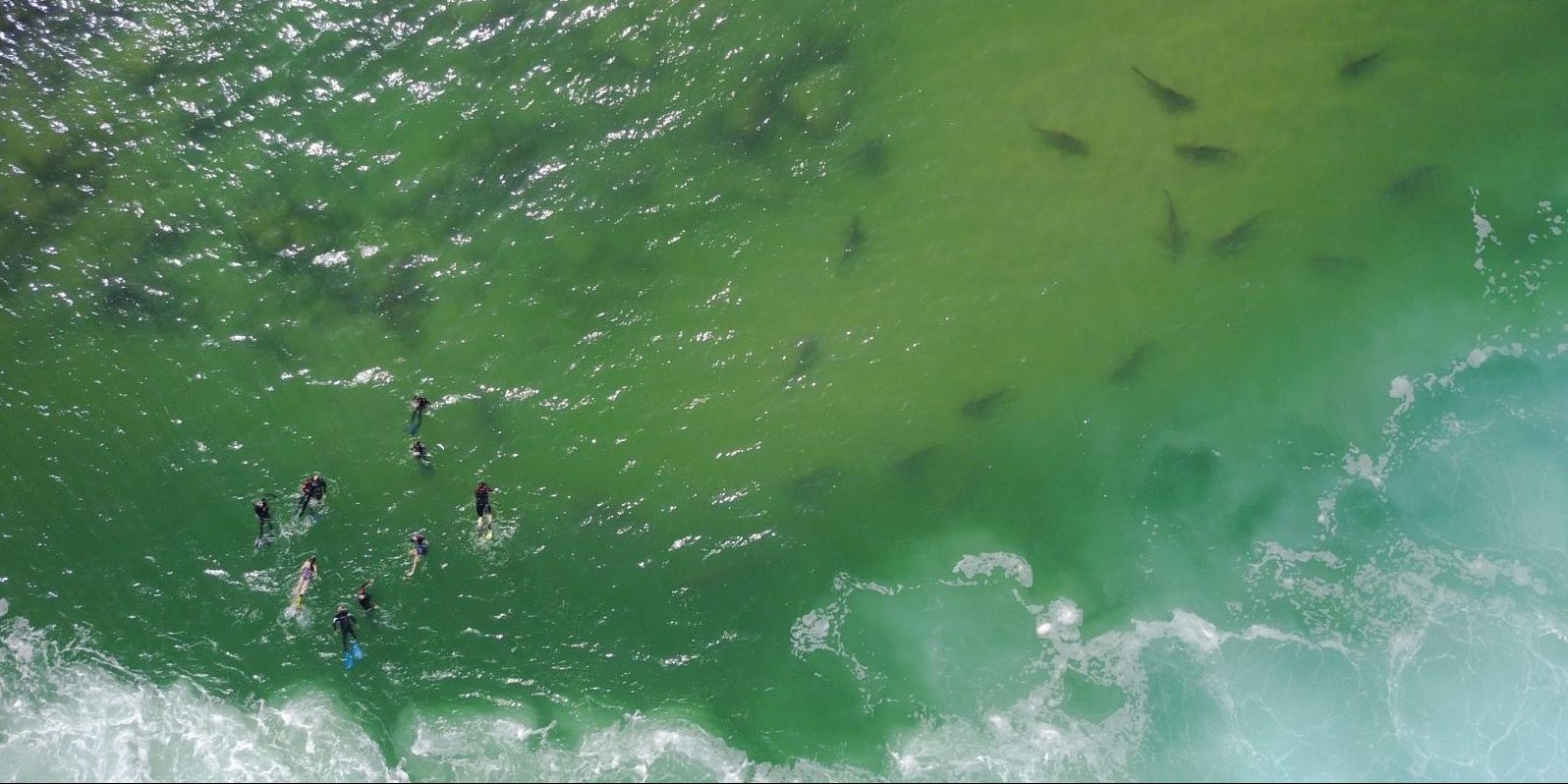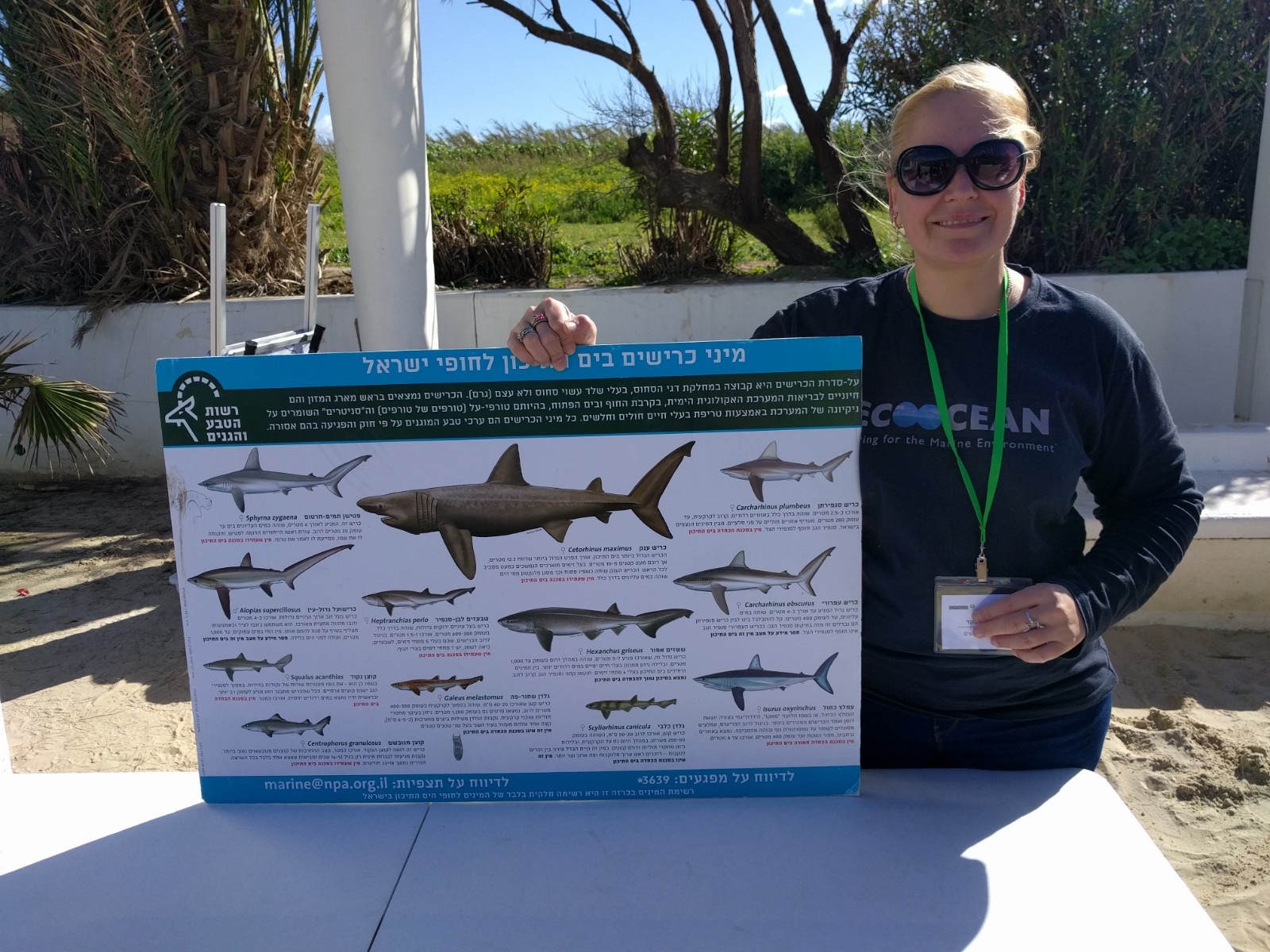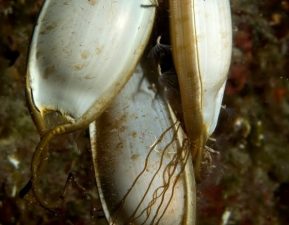
An annual gathering of sharks near a coastal power plant in the North of Israel attracts beachgoers, divers and sailors alike
Every Saturday in winter, curious spectators come together near the power plant in Hadera, on Israel’s Mediterranean coast, to witness the gathering of dozens of sharks. The spectacle takes place mainly between December and March, at the junction between the Hadera stream estuary and the OROT RABIN power station.
The reason for the shark’s arrival at the Israeli coastline has yet to be established, but it is certainly a unique phenomenon, as large shark populations are usually found at open sea. Strangely enough, in this case, the sharks gather in a narrow strip of less than half a mile. As part of the research into this fascinating natural event, some of the sharks have been tagged with acoustic transmitters and remote sensors.
The tagged individuals are a couple of four-meter-long female dusky sharks and a few male sandbar sharks, (which are slightly smaller and reach about 2.5 meters in length) both of which are classified as vulnerable species in the Mediterranean Sea and are listed in the red list of IUCN.
Local fishermen have known the phenomenon for a while, but with each year the number of sharks arriving at the beach increases, and their stay is getting longer. In the past, the fishermen would also encounter other shark species, such as Hammerheads, which are much larger, but rarely spotted these days.
A Selfie with a shark
Following the great interest of the public in the shark phenomenon, the Israel Nature and Parks Authority (INPA) together with the non-profit organization EcoOcean, researchers of the Morris Kahn Marine Research Station, the Hadera Municipality and with the support of the Society for the Protection of Nature in Israel (SPNI), have established an information station in the Haderastream, staffed with volunteers from the INPA and EcoOcean.

Photo by Alina Fischman
Besides providing information on the local shark population, the center offers educational activities for both travelers and dive instructors, in order to promote eco-tourism with sharks. Diving clubs in the region are already marketing diving packages alongside the sharks.
But despite all the efforts, researchers believe that the emerging shark tourism might have negative effects. For this very reason, Ziv Zemah Shamir, a doctoral student at the Morris Kahn Marine Research Station, established by the Charney School of Marine Sciences at the University of Haifa, devoted his doctoral thesis to examine the effects of people on sharks. The research takes place under the supervision of Dr. Dan Tchernov, head of the Morris Kahn Marine Research Station, and Dr. Aviad Sheinin, head of the Top Predator division at the station.
“In order to test behavioral changes in sharks, we used drone footage, kayak observations, diving surveys, and underwater acoustic devices. Also, we interviewed fishermen, divers, kayakers and beach visitors,” explains Zemah Shamir. “The results of the study show that the presence of divers and vessels affect the shark’s swimming activity, as they are trying to evade – change direction and speed, or conversely express interest in divers, cameras and electronic equipment (sharks have electromagnetic sensing capabilities). This comes at the expense of their hunting and resting time. In short, the sharks invest more energy into being attentive to the commotion around them than in looking for prey and going about their normal lives.”
Zemah Shamir, who spends most of his days alongside the sharks, says that he witnesses some aggressive behavior toward them – and even cases of shark hunting by rogue fishermen. “Two or three years ago, we came across quite a few fishermen who tried to hunt the sharks,” he says. “We are only at the beginning of our study, but we have already seen people trying to touch the sharks and take pictures with them, which does not cause physical damage, but certainly increases the stress level of the sharks.”
It should be noted that the two species of sharks occurring in this area are not aggressive toward humans, but there have been cases of attacks, however, none of which in Israel. “We have also observed incidents, using drone footage, in which sharks were fleeing from quickly approaching jet skis,” continues Zemah Shamir. “The water in this area is very shallow and the sharks have almost no chance to evade.”
”Trash and other debris left behind on the beach, most of it made of plastic, is sometimes washed in the sea, and eaten by various smaller fish, which are later swallowed by bigger fish, and eventually reach the shark’s stomachs,”, he explains. “Sharks are at the top of the marine food chain, therefore harming the lower levels will ultimately also affect the sharks.” Fishing waste (discarded fishing gear; nets, lines, hooks) in the water also has the potential to damage the variety of fish, including sharks. And indeed, sharks were observed with hooks in their mouths.
“They want to see sharks, and they want to see them now”
“Nowadays we often talk about the conflict between the practices of shark fishing and shark tourism. Obviously, we prefer shark tourism, because no sharks are harmed, but also because studies we’ve conducted show that shark tourism is more profitable”, says Zemah Shamir. “But you have to understand that shark tourism also comes at a price, and this price I try to quantify in my work. Evidence already exists, from our studies and from other parts of the world, that shark tourism has adverse effects on things like reproduction and migration.”
“If this phenomenon had taken place at sea, shark tourism could have been easily regulated and controlled,” he adds. “But here, because of its accessibility, people simply drive out to the Hadera stream, walk five minutes and arrive at the site. We also talk to the boat owners, but we have no control over those who come here from the sea. Some do not even have a license for their vessel, and they do not care about anything. They want to see sharks and they want to see them now. ”
Zemah Shamir makes a distinction between guidelines for visitors and for divers: the guidelines for beach travelers are to keep the beach and the sea clean and not to feed the sharks. In the past, he says, they have already encountered people arriving at the beach with whole chickens to feed the sharks.
The guidelines for divers are more detailed and include the scuba diving warnings of the Nature and Parks Authority and the Ministry of Culture and Sport. The reason there is a greater focus on scuba diving regulations stems from the fact that the area has strong currents and vortexes as a result of coastal infrastructure like the Hadera breakwater combined with a hot water influx coming from the power plant as well as desalination plant water.
“We plan to build an observation platform, which will hopefully open sometime this year. Moreover, there will be signs with information and activities for visitors who come to see the sharks,” explains Shira Salingre, of The Nature and Parks Authority. The project is a collaboration between the Society for the Protection of Nature in Israel (SPNI), the director of the Israel Diving Authority of the Ministry of Culture and Sport, Adam Konstantinovsky, the Israel Diving Federation and the “Sharks in Israel” group.
“We also want to ban fishing in the area. To this end, we are trying to work with the fishing authorities,” Salingre says. “As to sailors and divers, we are right now in the process of formulating behavioral codes to make sure we really do not interfere with the sharks to a degree that will harm them.
Although dive warnings have been positioned at the site, the IPA does not oppose diving in the area but instead wants to give divers the proper tools to avoid any disturbances to the animals while maintaining their own safety and interest. “We believe that if the municipality of Hadera decides to issue diving permits for the area, they should do so, having the proper scientific knowledge, which is why we provide them with guidelines,” she adds.
Until the project takes shape, and shark tourism on the site will be more organized, it is important to know that the general public, can do its bit to help protect the sharks by being respectful of the animal’s environment and by following the guidelines.



